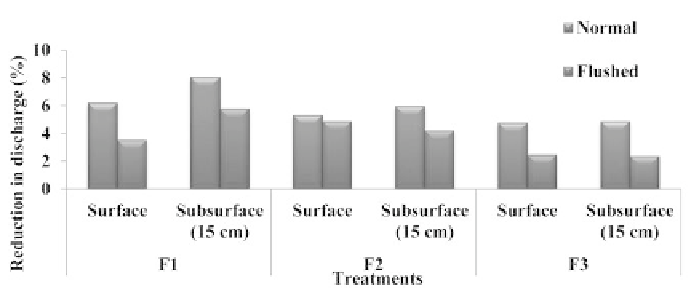Agriculture Reference
In-Depth Information
6.3.3 EFFECT OF FLUSHING AND FILTRATION SYSTEMS ON EMITTER
DISCHARGE
The effect of flushing and different filtration system on emitter discharge is presented
in Fig. 2. Flushing of main, submain and lateral removes the accumulation of sedi-
ments, dislodge bacterial slime and biofilms. Flushing was effective to improve the
discharge rate of emitters supplied through gravel media, disk and combination filters.
Maximum effectiveness in improving the discharge was observed under F1 in surface
drip (2.7%). Surface placement of lateral with F2 shows least improvement (0.5%).
It may be due to better filtration from F2, which is also evident from the filtration
efficiency of filters. Overall, higher improvements in flow rate of emitters under sub-
surface placed lateral were more than surface placed lateral in all the filtration system.
It may be due to flushing of soil particles from emitters under higher water velocity in
the path of emitters. To control the emitter clogging, acidification can also work but it
causes acidification of soil after long time application of acid flushing [21].
FIGURE 2
Effect of flushing and different filtration systems on reduction in emitter discharge.
6.3.4 EFFECT OF FLUSHING ON UNIFORMITY OF WATER APPLICATION
Variations in uniformity coefficients (UC) are presented in Table 3. Highest UC was
observed at beginning of the field experiment. After end of the season, UC decreases
considerably. However, performance of surface and subsurface drip system using both
filters combination comes under good category because UC was more than 95%. Simi-
lar observations were made by Puig-Bargues et al. [25].
TABLE 3
Uniformity coefficient resulting from the performance evaluation of drip irrigation
system.
Filter
Depth of
placement of
lateral
UC (%)
Beginning
End of
season
After flushing
Gravel media (F1)
Surface
98.59
96.26
97.41
15 cm
98.56
95.24
96.40























Search WWH ::

Custom Search